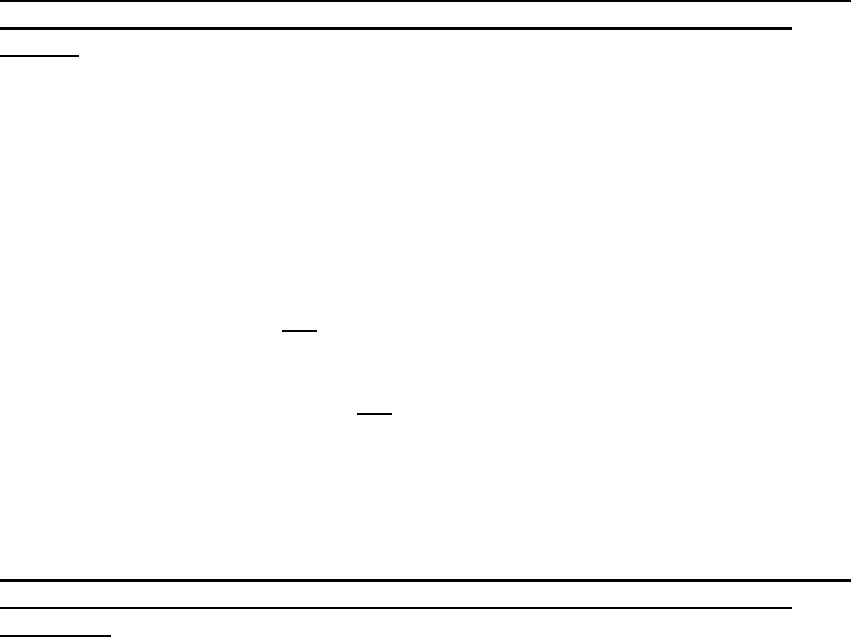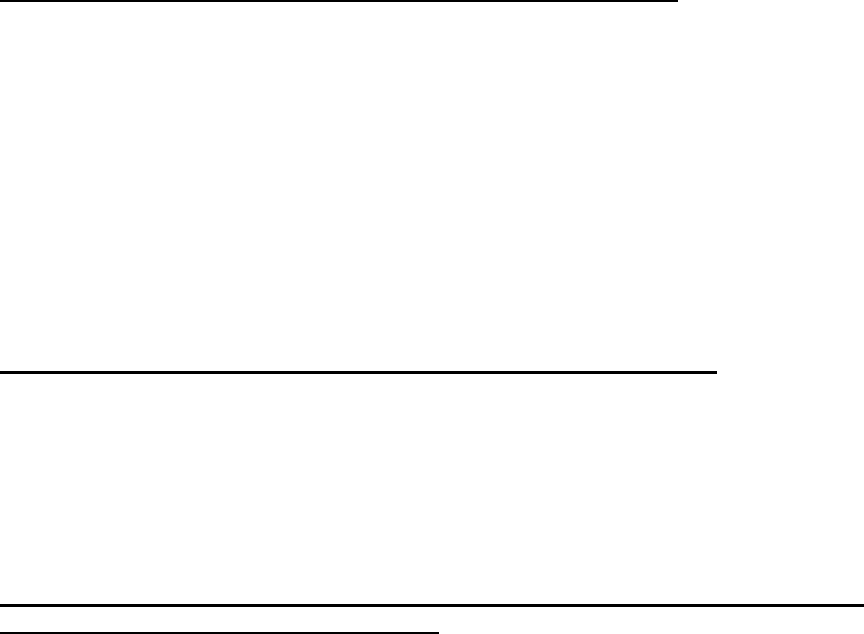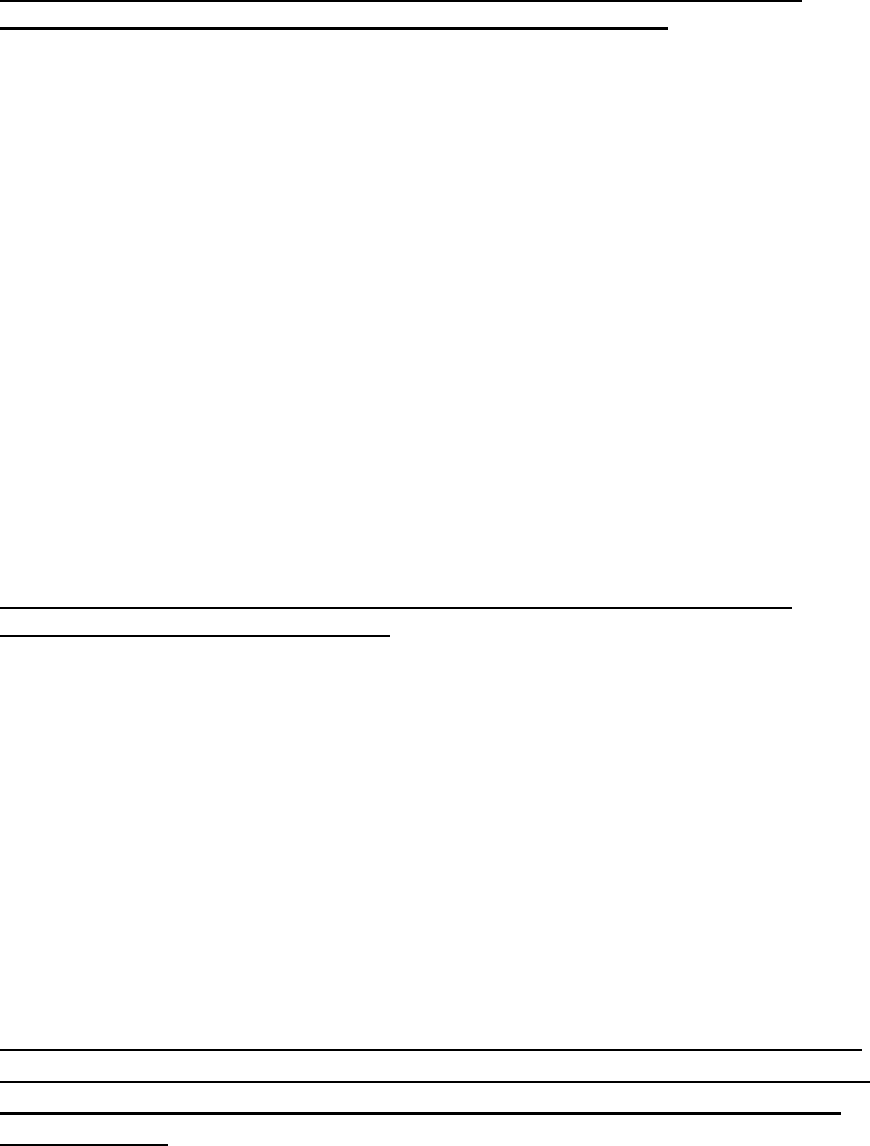
1
Questions and Answers Related to 49 CFR Part 225
Suggested by FRA’s Operating Practices Division and Office of Safety
In relation to the Office of Inspector General’s Recommendation No. 1:
“Update reporting guidance so users can more efficiently and accurately
identify reporting requirements for different accident and incident types and
better understand the definitions of terms used on reporting forms.”
I. Highway-Rail Grade Crossing Accident/Incident Reporting – Form F 6180.57:
Additional clarification – Definition of Highway-Rail Grade Crossing Accident
Interpretation – Highway user swerves off roadway in an unsuccessful attempt to
avoid impact
Interpretation – Impacts with lading being transported and protruding from a highway
user
Coding clarification – “Sports Utility Vehicle”, Item 13, “Type of Highway User”
Coding clarification – “Video Taken”, Item 53a, “Special Study Block”
Coding clarification – “Drug/Alcohol Tests”, Item 54, “Narrative Description”
II. Reportable Rail Equipment Accident/Incident Reporting – Form F 6180.54:
Additional clarification – Definition “Head on Collision vs. Obstruction Accident.”
Additional clarification – Definition “Raking Collision vs. Obstruction Accident.”
Additional clarification – Definition “Obstruction Accident.”
Additional clarification – Definition “Equipment Damage.”
Additional clarification – Definition “Track Damage.”
Additional clarification – Definition “Reportable Damage.” (Wheel Set Change Out)
Additional clarification – Definition “Reportable Damage.” (Cars with roller bearings
submerged)
Additional clarification – Reporting of Track Information.” (Accidents involving
consists on separate tracks)
Additional clarification – Traction Motor Event (Fire)
Additional clarification – Traction Motor Event (Failure)
III. Casualties to Persons Reporting - FRA Form F 6180.55a:
Interpretation – Day Away from Work
Interpretation – Medical Treatment (EpiPen)
Interpretation – Event arising from the operation of a railroad
Interpretation – Event NOT arising from the operation of a railroad
Interpretation – Casualty at a highway-rail grade crossing without the presence of
railroad employees or on-track equipment – Example No. 1
Interpretation – Casualty at a highway-rail grade crossing without the presence of
railroad employees or on-track equipment – Example No. 2
Interpretation – Casualty to Person struck by train, NOT at a Highway-Rail Grade
Crossing

2
Interpretation – Casualty to Persons in highway vehicle struck tree, NOT at a
Highway-Rail Grade Crossing
Interpretation – Casualty to the other driver involved in a company vehicle accident on
public street/highway, NOT on railroad property
IV. Recordkeeping – FRA Forms F 6180.97 and F 6180.98:
Recordkeeping – General
Recordkeeping – Form F 6180.97 – Initial Rail Equipment Accident/Incident Record
Recordkeeping – Form F 6180.98 – Employee Injury and/or Illness Record
V. Internal Control Plan
Requirement – Internal Control Plan
VI. Start-up of New Commuter Railroads
Interpretation – Commuter Railroads with several separate contractors providing
contracted employees
Interpretation – When does a new commuter railroad need to have an Internal Control
Plan?
Interpretation – When does a new commuter railroad become a “railroad” for purposes
of FRA Reporting and Recordkeeping responsibilities?
Interpretation – What if a railroad has not hired employees and used another railroad
to operate its first test train?
Interpretation – After our first test train, there was additional track and signal work
being accomplished. A derailment of a “Work Train” subsequently
occurred during this track enhancement. What railroad would be
required to report this derailment of the “Work Train?”
Interpretation – Responsibility for reporting injuries during construction
enhancement of the freight railroad’s track and signals?
VII. Holding Companies
Interpretation – Injuries to Employees of a Holding Company, NOT on railroad
property
Interpretation – Employees of a Holding Company, Reporting of Hours Worked
Federal Railroad Administration
Washington, DC
August 1, 2017

3
I. Group I Reporting – Highway-Rail Grade Crossing Accidents - FRA Form F
6180.57:
Interpretation – Definition of a Highway-Rail Grade Crossing Accident/Incident
Q. Our freight train was operating through a congested area of a city when it struck
and fatally injured a trespasser who was walking on a pathway that crossed our
tracks. I see that FRA’s definition of a Highway-Rail Grade Crossing Accident
now includes “pathways”, which reads as follows:
“(2) a location where a pathway explicitly authorized by a public authority
or a railroad carrier that is dedicated for the use of non-vehicular traffic,
including pedestrians, bicyclists, and others, that is not associated with a
public highway, road, or street, or a private roadway, crosses one or more
railroad tracks at grade.”
Would this be considered a pathway in relation to the definition of a highway-rail
grade crossing accident, and would a Form FRA F 6180.57 be required?
A. It was determined that this path was not authorized by any public authority, or by
the railroad. The path did not have an assigned DOT identification number, and
should not have been assigned one because it was an unauthorized pathway. Steps
were taken after this accident to install fencing to discourage persons from
trespassing over the tracks at this unauthorized pathway. Under these
circumstances, this accident would not be considered to have occurred at a
highway-rail grade crossing. It would be classified as a trespasser strike, NOT at a
crossing.
Interpretation – Definition of a Highway-Rail Grade Crossing Accident/Incident -
Highway user swerves off roadway in an unsuccessful attempt to avoid impact:
Q. A highway user swerved to avoid striking railroad on-track equipment at a
crossing, left the roadway, and subsequently struck a portion of the railroad on-
track equipment. The collision did not occur at the grade crossing proper, but 30
feet off of the crossing. Does the operating railroad have to submit a Form FRA F
6180.57 - Highway-Rail Grade Crossing Accident/Incident Report?
A. As the highway user’s actions seem to demonstrate that they were attempting to
avoid colliding with the on-track equipment, this scenario would fall under
“Location of Actual Impact,” and therefore must be reported as a Highway-Rail
Grade Crossing Accident/Incident on Form FRA F 6180.57. See FRA Guide for
Preparing Accident/Incident Reports Section 10.3.
10.3 General Instructions and Interpretations
Location of Actual Impact. Incidents involving highway users who have
unsuccessfully attempted to avoid striking or being struck by railroad on-
track equipment at a crossing site are to be reported, regardless of where
the actual impact between the consist and the highway user occurred.

4
Interpretation – Definition of a Highway-Rail Grade Crossing Accident –
Impacts with lading being transported and protruding from a highway user:
Q. Our train was operating at approximately 40 mph when a log truck crossed the
tracks ahead at a public crossing. After sounding the locomotive horn, it appeared
that a collision was imminent, so our engineer placed the train in emergency. The
log truck itself was not struck, but the lead locomotive struck one of the large logs
protruding over the end of the truck. The force of the collision caused the entire
log truck and load of logs to overturn. As the collision was with a large log being
transported by the log truck, and not the truck itself, would this accident need to be
reported on FRA Form F 6180.57 as a highway-rail grade crossing accident?
A. Yes. In this case, at the time of the impact, the log was being transported by the
log truck and was a part of the highway user’s vehicle (lading) that was crossing
the railroad tracks. The same would be true for other types of lading protruding
from the rear of a highway user’s vehicle, such as a flatbed truck transporting pipe.
However, if lading that had fallen earlier from a highway user, such as a log falling
from a log truck, and was then struck by the train at the crossing, this would not
meet the definition of a highway-rail grade crossing accident as a highway user
was not involved at the time of the accident. This type of incident would be an
“Obstruction Incident”. See FRA Guide for Preparing Accident/Incident Reports
Chapter 2.
Interpretation – Clarification of Item 13, “Type of Highway User,” FRA Form F
6180.57, Highway-Rail Grade Crossing Accident/Incident Report - Sports Utility
Vehicle:
Q. During the course of a year, our Class I railroad has had several highway-rail grade
crossing accidents in which our train struck, or was struck by, a Sports Utility
Vehicle (SUV). However, there is no code available among the various choices in
Item 13, “Type of Highway User”. We have called FRA’s Project Office, and
have been told we should use code J, “Other Motor Vehicle,” and to enter the
specific type of vehicle (SUV) in Item 54, “Narrative Description,” of FRA Form
F 6180.57. We have been doing this, but we suggest that on a future form
revision, FRA consider adding a new code to add “SUV” to the choices that we
have in Item 13.
A. Yes. This point is well taken, and FRA will plan to do so. FRA has knowledge of
other common types of vehicles that will also be considered for new codes in Item
13, such as “Pick-up truck with trailer”.
Interpretation – Clarification of Item 53a, “Special Study Block,” FRA Form F
6180.57, Highway-Rail Grade Crossing Accident/Incident Report - Video
Taken/Video Used:
Q. I am preparing a Form FRA F 6180.57 for a highway-rail grade crossing accident
that occurred about five weeks ago. The report to FRA is due no later than the

5
end of this month. I am attempting to answer the Video Taken boxes in Block
53a, “Special Study Block.” The lead locomotive of our train was equipped with
a forward facing camera, but when the video was processed, the view of the impact
was not recorded. How do I answer the Video Taken question, “Yes” or “No”?
A. The “No” box would be marked for “Video Taken” because the forward facing
camera on the lead locomotive did not record the grade crossing accident. The
entry instructions for “Video Taken,” state, in part, to “Indicate whether the
highway-rail grade crossing accident was recorded by a locomotive video
recorder….” See FRA Guide for Preparing Accident/Incident Reports Section
10.4, Item 53b.
Interpretation – Clarification of Reporting Drug/Alcohol Testing for any Human
factor caused Highway-Rail Grade Crossing Accident/Incident on Form FRA F
6180.57, “Highway-Rail Grade Crossing Accident/Incident Report - Item 54,
“Narrative Description,” - Drug/Alcohol Testing Codes:
.
Q. Yesterday, our train struck an automobile at a highway-rail grade crossing. We
determined the active crossing warning system had an activation failure, and all
train crews had been given the proper restriction to stop and provide flag
protection before moving over the crossing. The crew on the train striking the
automobile at this crossing did not stop in accordance with the mandatory
directive, and struck the vehicle. As this crossing accident met the definition of
being a “Human-factor highway-rail grade crossing accident/incident” under the
provisions of 49 CFR 219.201, we performed drug/alcohol testing of our two crew
members. We are now completing FRA Form F 6180.57, “Highway-Rail Grade
Crossing Accident/Incident Report”. However, we have found this FRA report
does not provide for an entry field for “drug and/or alcohol testing”. Are we to
report this drug/alcohol testing, and if so, how do we do so?
A. Yes, railroads are to report drug/alcohol testing on all reports made to FRA for
reportable accidents/incidents and casualties to persons whenever drug/alcohol
testing is performed in relation to the accident/incident. This requirement became
effective on June 12, 2017. See 49 CFR 219.201. As a part of the several
revisions made to Appendix C of 49 CFR Part 219, the previous blanket exclusion
of highway-rail grade crossing accidents from the requirement for drug/alcohol
testing was eliminated. The revised regulation now includes five circumstances
for which railroad employees would be subject to Post-Accident Toxicological
Testing if the cause of the grade crossing accident was determined to have met the
definition of being a “Human-factor highway-rail grade crossing
accident/incident.” See 49 CFR 219.201.
FRA has not revised its standard form, FRA F 6180.57, “Highway-Rail Grade
Crossing Accident/Incident Report,” in relation to this change in Part 219. FRA is
considering adding a new item on Form FRA F 6180.57 next time the form is
revised. FRA is also considering the addition of instructions for entry of

6
“drug/alcohol testing codes” to Chapter 10 of a revised FRA Guide for Preparing
Accident/Incident Reports.
Until the revised FRA Form F 6180.57, and the new entry instructions, are
published, FRA is requesting that railroads enter any drug/alcohol test coding into
Item 54, “Narrative Description,” on FRA Form F 6180.57 in the same manner
described in the current FRA Guide for entry into FRA Form F 6180.54, “Rail
Equipment Accident/Incident Report.” See FRA Guide for Preparing
Accident/Incident Reports Section 32.
“32. Railroad employees tested for drug/alcohol use.
If any employee was tested for alcohol usage in connection with this
accident, enter the number of positive tests in the first block. If any
employee was tested for drug usage in connection with this accident,
enter the number of positive tests in the second block. If testing was
performed and the results were negative, enter “0.” If there were positive
tests, but impairment is not reported as a cause of the accident, then
provide a brief explanation in the narrative of the basis for this
determination. You are required to identify all accidents/incidents where
either Federal- or employer-authorized tests were performed. Note: The
same drug and alcohol code should be reported on all corresponding
Form FRA 6180.54’s and Form FRA 6180.55a’s that are filed under the
same accident/incident number.”

7
Group II Reporting – Reportable Rail Equipment Accidents - FRA Form F 6180.54, FRA
Guide, Chapter 7:
Interpretation and Clarification: Item 7, “Type of Accident/Incident,” Rail
Equipment Accidents, FRA Form F 6180.54, “Rail Equipment Accident/Incident
Report – “Head on Collision versus Obstruction Incident”:
Q. We recently had a tragic accident when one of our westbound freight trains
operating on the main track collided head-on with our track supervisor, who was
operating eastbound on the main track in his Hi-Rail inspection vehicle. The track
supervisor was able to jump from his vehicle prior to the impact, and survived with
multiple injuries. The combined damages to the two on-track consists exceeded
the current monetary threshold limit for reporting to FRA. I am now in the process
of preparing two FRA Forms F 6180.54s, one for each consist, and one FRA Form
F 6180.55a for the non-fatal injury to our track supervisor. For entry into Item 7,
“Type of Accident/Incident”, for both consists, I have entered code 01, “Head on
Collision”. Is this the correct choice?
A. No. The correct code for Item 7, “Type of Accident/Incident,” is code 09,
“Obstruction Incident.” FRA is concerned and thus instructing railroads to not use
code 01, “Head on Collision,” for cases such as this. The term “Head on
Collision” has traditionally been recognized in the railroad industry as the deadliest
among the types of collisions, and this is why the definition limits code 01 only to
accidents that involve trains or locomotives operating in opposite directions on the
same track. The definition for a “Head on Collision” is, “A collision in which the
trains or locomotives, or electric multiple unit (EMU) or diesel multiple-unit
(DMU) trains, involved are traveling in opposite directions on the same track,
provided that both consists have a locomotive (or EMU or DMU trains).” See
FRA Guide for Preparing Accident/Incident Reports Section 2.
Interpretation and Clarification: Item 7, “Type of Accident/Incident,” Rail
Equipment Accidents, FRA Form F 6180.54, “Rail Equipment Accident/Incident
Report – “Raking Collision versus Other Impact”:
Q. One of our yard assignments was pulling 30 cars out of Track No. 37, and, as the
engineer was approaching the yard lead switch, he noticed a single car had been
left beyond the clearance point and was in the foul. He placed the train into
emergency, but was unable to stop in time and the corner of the locomotive
sideswiped the corner of the freight car that had been left in the foul. The damages
to the locomotive and the car exceeded the threshold for reporting to FRA as a
reportable rail equipment accident. In Item 7, “Type of Accident/Incident”, we
had entered code 05, “Raking Collision”. However an FRA Inspector later
inspected our reports and took exception for us using the code 05, “Raking
Collision”, for the type of accident/incident. He said the circumstances of this
accident did not meet the definition of a “Raking Collision”, and that code 12,
“Other Impact”, would have been the proper entry. Can you explain why this
would not be a “Raking Collision”?

8
A. A “Raking Collision” is defined as: “A collision between parts or lading of a
consist on an adjacent track, or with a structure such as a bridge.” See FRA Guide
for Preparing Accident/Incident Reports Section 2. In the question above, the
locomotive collided with the freight car. There was no shifted lading, or unusual
protruding parts.
The intent of the definition is to describe situations such as:
(1) An accident in double or multiple track territory with two trains operating
in different directions on adjacent tracks. Unknown to the crew of one
train, a trailer being transported has become unsecured from its mount, and
has shifted so as to foul the adjacent track. A train operating on the
adjacent track in the opposite direction then passes the train with the shifted
trailer, and the locomotive collides with the shifted trailer on the flatcar, or
(2) An accident on single, double, or multiple track territory when parts or
lading of a train strikes the side supports of a bridge or similar structure.
Interpretation and Clarification – Definition of “Obstruction Accident”:
Q. Chapter 2, “Definitions”, of the FRA Guide contains a definition for an
“Obstruction Incident”:
1) a bumping post or a foreign object on the track right-of-way;
2) a highway vehicle at a location other than a highway-rail grade crossing
site;
3) derailed equipment; or
4) a track motorcar or similar work equipment not equipped with AAR
couplers and not operating under train rules.
Can you further clarify the types of rail equipment accidents that would be
classified as an “Obstruction Incident”?
A. The following serves to clarify the four categories for classifying a rail equipment
accident as an “Obstruction Incident”:
1) The first category can consists of a bumping post placed at the end of a
yard track or at an industry. A foreign object incident, such as a fallen tree
or debris from storms, objects placed by vandals, objects unintentionally
left or placed in the foul of the track, or animals and other wildlife, can be
on the track right-of-way and fouling the track.
2) The second category can involve a highway vehicle or a person at a
location other than a highway-rail grade crossing site. An exception exists
for a highway vehicle or person that had intentionally swerved off the road
crossing to avoid an impact with a train at the crossing.

9
3) There is no additional clarification necessary for the third category.
4) The fourth category can include a track motorcar or similar work
equipment not equipped with AAR couplers and not operating under train
rule. For example, should an on-track inspection or maintenance hi-rail
vehicle be involved in an impact with a train, locomotive, or other on-track
equipment, this type of incident would be not meet the definition of being a
“collision”. Rather, it would be classified as an “Obstruction Incident”.
Additional Clarification - Definition of “Equipment Damage”:
Q. We recently had an electrical fire on one of our locomotives. The fire was
confined primarily to the electrical cabinet in the cab of the locomotive. However,
the fire did cause additional damage to the wiring to the speed indicator and other
instruments in the cab of the locomotive. The instruments were also damaged and
needed to be replaced. To fix the damaged speed indicator and other instruments
in the locomotive, we removed the needed parts from another locomotive that was
out-of-service. As we did not use any new parts, and because we would be
scrapping the out-of-service locomotive, we did not include any of the costs for
removing the instruments from the out-of-service locomotive or the cost of re-
installing the instruments in the locomotive that had the electrical fire. The labor
and material to repair the electrical cabinet and wiring was $9,500. Were we
correct by excluding the labor and material costs for removing the instruments
from the out-of-service locomotive, and installing them in the locomotive involved
in the fire?
A. No. All costs associated with the labor and material for the “repair or replace in-
kind” of on-track equipment should have been charged. These costs include the
labor to remove the instruments from the out-of-service locomotive, the
depreciated material cost of the instruments, and the labor cost to re-install the
instruments in the fire-damaged locomotive. See FRA Guide for Preparing
Accident/Incident Reports Section 2. The amount of equipment damage involved
in this locomotive fire should be reassessed to include these additional costs. If the
threshold limit for the year in which the fire occurred was exceeded, a late FRA
Form F 6180.54 should be prepared and submitted to FRA.
“Equipment Damage. All costs, including labor and material, associated
with the repair or replacement in-kind of on-track rail equipment. This
would include the cost of labor and material to repair or replace in-kind,
all parts, appurtenances, including fasteners, on the on-track equipment
damaged in the accident. When locomotive parts, appetences, etc., are
damaged beyond repair, the current cost of new materials is to be used.
However, replacement of secondhand parts, appurtenances, etc., with
secondhand parts, appurtenances, etc., may be charged at the current
cost of such parts, appurtenances, etc..” Trailers/containers on flatcars
are considered to be lading and damage to these is not to be included in
on-track equipment damage. Damage to a flatcar carrying a
trailer/container is to be included in reportable damage.”

10
Additional Clarification - Definition of “Track Damage”:
Q. We recently had a derailment in one of our yards that destroyed approximately 200
feet of track, consisting of several sections of 39 foot rail and numerous ties. We
had on hand a large quantity of used 39 foot rail and numerous ties that had
recently been removed from an abandoned section of main line track. We used
the secondhand rail and ties to repair the destroyed track. The cost of the labor
involved was $9,500, so the accident did not exceed the threshold limit for
reporting to FRA. As we did not use any new rail or ties, and because we would
have sold the secondhand rail and ties, we did not include any of the costs for the
replacement rail or ties. Were we correct by excluding the material costs for our
use of the second-hand rail and ties?
A. No. The current definition of “Track Damage” states that “All costs, including
labor and material, associated with the “repair or replace in-kind” of signals, track,
track structures (including bridges, or tunnels), damaged equipment detectors (e.g.,
hot box detector, etc.), switches, or other electronic equipment; or roadbeds that
were damaged in a collision, derailment or other event,” are to be included. See
FRA Guide for Preparing Accident/Incident Reports Section 2. This present
definition further states that, “When track, signals, structures, etc., are damaged
beyond repair, the current cost of new materials is to be used. However,
replacement of secondhand rail with secondhand rail may be charged at the current
cost of such rail.” See FRA Guide for Preparing Accident/Incident Reports
Section 2.
Additionally, the question stated there was no material costs associated with the
track damage. However, it would appear that new spikes and rail fasteners would
have had to have been used in this instance, and those would need to be included in
the track damage cost of this derailment. The amount of track damage involved in
this derailment should be reassessed to include those additional costs. If the
threshold limit for the year in which this derailment occurred was exceeded, a late
FRA Form F 6180.54 should be prepared and submitted to FRA.
“Track Damage. All costs, including labor and material, associated with
the repair or replacement in-kind of signals, track, track structures
(including bridges or tunnels), damaged equipment detectors (e.g., hot
box detector), switches, or other electronic equipment; or roadbeds that
were damaged in a collision, derailment, or other reportable event. This
would include the cost of labor and material to repair or replace in-kind,
all parts, to include fasteners to track, signal and roadway appliances,
damaged in the accident.
When track, signals, structures, etc., are damaged beyond repair, the
current cost of new materials is to be used. However, replacement of
secondhand rail with secondhand rail may be charged at the current cost
of such rail.”

11
Interpretation – Definition of Reportable Damage for Rail Equipment Accidents,
FRA Form F 6180.54, “Wheel Set Change Out”:
Q. Our railroad adopted a proactive approach to make a “wheel set change out”
whenever there is a derailment. Would this process be included in “reportable
damage” to the FRA?
A. If the railroad elected to make a “wheel set change out”, the FRA Guide says this
is “replacement cost,” and thus is considered as “reportable damage.” See FRA
Guide for Preparing Accident/Incident Reports Section 2. Replacement costs
associated with a “wheel set change out” also include the labor costs resulting from
that change out, damaged on track equipment, signals, track, track structures, or
roadbed. See FRA Guide for Preparing Accident/Incident Reports Section 2.
Reportable damage does not include the cost of clearing a wreck. However, if
additional damage to the above listed reportable items is caused while clearing the
wreck, that damage must be included in the damage estimate. See FRA Guide for
Preparing Accident/Incident Reports Section 2.
Interpretation – General Requirement for Rail Equipment Accidents, FRA Form F
6180.54, “Rail Equipment Accident/Incident Report – “Numerous Freight Cars
having roller bearings submerged in high water:”
Q. During the recent hurricane that struck this area, our entire rail yard near the Port
was flooded by the storm surge. The water was as high as five feet deep. When
we were able to ascertain the extent of damages, we determined there were a total
of 107 freight cars that had their roller bearing journals submerged, and which
would need to have wheel sets removed and replaced. Is this considered to be a
rail equipment accident/incident? If so, how would we properly comply with
FRA’s record keeping and reporting regulations?
A. Yes, this type of incident would be considered a rail equipment accident/incident.
In this case, each car involved would have costs associated with the labor and
repair or replacement costs for a wheel change out, thus making this incident an
“Accountable Rail Equipment Accident.” As such, this incident would need to be
recorded on FRA Form F 6180.97, “Initial Rail Equipment Accident/Incident
Record.” Based upon the number of cars involved, this incident may exceed the
threshold limit for being a reportable rail equipment accident, and a FRA Form F
6180.54, “Reportable Rail Equipment Accident/Incident Report”, would be
required.
To assist parties in complying with the requirement of preparing both a FRA Form
F 6180.97 and FRA Form F 6180.54 for each consist involved, FRA allows each
track, rather than each individual car, with submerged cars to be considered a
separate consist in situations such as this.

12
As an example, assume the total material and labor to change out the wheel sets for
the 107 cars was $500 per car, for a total of $53,500. The 107 cars were located on
the 7 separate tracks:
Track No. 10 - 13 submerged cars times $500 per car = $6,500
Track No. 11 - 6 submerged cars times $500 per car = $3,000
Track No. 15 - 20 submerged cars times $500 per car = $10,000
Track No. 17 - 15 submerged cars times $500 per car = $7,500
Track No. 20 - 22 submerged cars times $500 per car = $11,000
Track No. 21 - 15 submerged cars times $500 per car = $7,500
Track No. 23 - 16 submerged cars times $500 per car = $8,000
Total - 107 submerged cars times $500 per car = $53,500
Using this methodology, a railroad would need to complete seven separate FRA
Form F 6180.97s, and seven separate FRA Form F 6180.54s, to satisfy the separate
consist requirement for such cases that arise by natural disasters, or by accidents
caused by an “Act of God”. This minimizes the workload by the railroads treating
each track of cars as a separate consist, regardless of whether all cars are coupled
in the track or not.
Interpretation – Requirement for Reporting of Track Damage information in Item
37, “Track, Signal, Way and Structure Damage,” Reportable Rail Equipment
Accidents, FRA Form F 6180.54, “Rail Equipment Accident/Incident Report -
“Track Damage to be reported for Accidents having 2 or more consists”:
Q. We recently had a derailment that met the standards for a reportable rail equipment
accident. As the cars were derailing, some of the derailed cars struck the side of
cars in another train operating on an adjacent track. We know we need to submit
two separate Forms FRA F 6180.54 for this accident, and because the first event
that occurred was the derailment, that the Type of Accident/Incident on both
reports would be entered as code 1, “Derailment”. However, we are having
difficulty in completing the track information for this accident. The train that
derailed was on a Main track of our ALPHA subdivision, but the train on the
adjacent track that was struck by the derailed equipment was operating on a siding
on our BRAVO subdivision. In addition to the different subdivision names, the
milepost for where the accident occurred is different. Additionally, the Annual
Track Density, the Type of Track, the Name of Track, and the Type of Rail (CWR
or OTH) are all different. Should we be filling out the track information on the
separate FRA Forms F 6180.54 in this manner?
A. No. The best approach for situations such as this is to complete the track
information for both consists based upon the track information for the first event
that occurred (i.e. the point of derailment), and not the track information for the
adjacent track on which the second event (i.e. the byproduct of the derailment)
occurred.

13
Interpretation – General Requirement for Rail Equipment Accidents, FRA Form F
6180.54, “Rail Equipment Accident/Incident Report – Traction Motor Events
(Fire)”:
Q. One of the locomotives on our freight trains had a traction motor fail and catch
fire. There was no derailment involved. The crew stopped their train and a local
fire department was called to extinguish the fire. Subsequent inspection revealed
the fire also damaged electrical cables and connections. Would this type of
mechanical issue be considered as a rail equipment accident/incident?
A. Yes. This type of event would have costs involved and would thus meet the
definition of an Accountable Rail Equipment Accident, more specifically a “Fire
or Violent Rupture”. See FRA Guide for Preparing Accident/Incident Reports
Section 2. This event would need to be recorded on FRA Form F 6180.97, “Initial
Rail Equipment Accident/Incident,” within seven working days of the railroad
having learned of the event. See 49 CFR 225.25(f); FRA Guide for Preparing
Accident/Incident Reports Section 5.1. If the damages to the traction motor and
other electrical components were in excess of the current threshold limit, the case
would also be considered a Reportable Rail Equipment Accident, and must be
submitted on FRA Form F 6180.54.
Interpretation – General Requirement for Rail Equipment Accidents, FRA Form F
6180.54, “Rail Equipment Accident/Incident Report – Traction Motor Events
(Failure)”:
Q. We had an incident when a locomotive on a freight train had a traction motor fail,
and the engineer stopped the train. There was no derailment, and the only damage
found was to the traction motor itself. There was smoke, but no visible fire, and no
other electrical components or other parts of the locomotive damaged in this event.
Would this type of mechanical issue be considered as a rail equipment
accident/incident?
A. No. There is a difference between this type of traction motor failure that causes no
derailment or damage except to the traction motor itself, and those events where
the traction motor failure causes a derailment or damage to other electrical
components or parts of the locomotive. With these facts, this type of event would
not be considered a “Fire or Violent Rupture”, and would not meet the definition
of being an Accountable Rail Equipment Accident. If all damage relates to the
traction motor itself, there would be no regulatory need to complete a Form FRA F
6180.97. However, FRA would suggest the railroad complete a FRA Form F
6180.97 for purposes of creating an audit trail in the event questions should later
arise about cases such as these.

14
Group III Reporting – Casualties to Persons, FRA Form F 6180.55a – FRA Guide, Chapter
6:
Interpretation – Day Away from Work:
Q. A railroad employee claimed an injury, but did not seek medical attention. The
next day, the employee took the day off with the consent of the railroad. Would
this case be reportable to the FRA because of “Lost time”?
A. No. As the employee did not seek medical attention, FRA would view this case as
“self-treating”. Additionally, the FRA definition of “Days away from work” was
not met in this case as the employee was not examined by a physician or other
licensed health care professional and diagnosed with a work-related injury or
illness. See 49 CFR 225.5.
“Day away from work means a day away from work as described in
paragraph (1) of this definition or, if paragraph (1) does not apply, a day
away from work solely for reporting purposes as described in paragraph
(2) of this definition. For purposes of this definition, the count of days
includes all calendar days, regardless of whether the employee would
normally be scheduled to work on those days (e.g., weekend days,
holidays, rest days, and vacation days), and begins on the first calendar
day after the railroad employee has been examined by a physician or
other licensed health care professional (PLHCP) and diagnosed with a
work-related injury or illness. “
Interpretation – Medical Treatment:
Q. A railroad employee had previously been prescribed by a physician a prescription
medication to be carried by the employee, and designed to be self-administered in
the form of an inhaler or by injection using an Epi Pen in event of an exposure. An
event requiring its use occurred, and the employee immediately utilized this self-
administered prescription medication. The employee did not seek medical
attention after the event and use of this self-administered prescription medication.
Would this case be reportable to the FRA?
A. Yes. If an inhaler or an Epi Pen injection was authorized by a Physician or Other
Licensed Health Care Professional (PLHCP), it does not matter who administered
the prescription medication.
“In regard to the question of self-administration, the answer is “Yes,”
this must be reported. If prescription medication is authorized for use by
a PLHCP, it makes no difference who administers the medication.”

15
Interpretation – Events arising from the operation of the railroad:
Q. A customer for a passenger railroad was walking up a staircase on the railroad’s
property, fell, and sustained an injury requiring more than first aid. The railroad
inspected the staircase and found no defects. Does the railroad have to report this
case?
A. Yes. The criteria would be met if this is an event that occurred on railroad
property, and the staircase was considered necessary for the operation of the
railroad. If the railroad is uncertain as to the extent of the individual’s injuries, the
FRA expects the railroad to document its efforts to contact the individual to
identify the extent of any injuries. If the railroad’s attempts prove futile, then there
is no need to report.
Interpretation – Events not arising from the operation of the railroad:
Q. A passenger was onboard a train and fainted. There were no crowding conditions
or operational issues with the train, e.g., no smoke, no fumes. Does the railroad
have to report this type of case?
A. If there was no event from the operation of the railroad that triggered the passenger
to faint, then the railroad would not have to report this type of event.
Interpretation – A Casualty at a highway-rail grade crossing without the presence of
railroad employees or on-track equipment.
Q. Our railroad had an incident that occurred at a highway-rail grade crossing. There
were no railroad personnel at or near the crossing, and no presence of any on track
rail equipment. There was no impact at all with the highway vehicle involved.
What happened was that, earlier in the evening and unknown to us, one of our
freight trains had dragging equipment and, when it passed over the crossing in
question, the rubberized matting between the rails at the crossing was torn out.
After the matting was torn out, the driver of an automobile proceeding down the
street at the posted speed limit of 35 mph struck the damaged crossing area. The
wheels of the automobile struck the rails, causing the driver to be propelled
upwards, hit her head on the inside top of the automobile, and to fracture her neck.
Under 49 CFR 225.15, “Reporting Exceptions”, subparagraph (a) reads, “(a)
Persons other than railroad employees. A railroad is not to report injuries that
occur at highway-rail grade crossings that do not involve the presence or operation
of on-track equipment, or the presence of railroad employees then engaged in the
operation of a railroad….” Does this mean that we are not required to submit a
Form FRA F 6180.55a for this case?
A. No. This would be an exception to the general guidance that has been provided in
49 CFR Section 225.15. In this case, there is clearly the existence of an accident
that “arose from the operation of the railroad.” As such, FRA is charged with
collecting the case information because it discloses a hazard to the general public.
The case would meet FRA reporting criteria because the highway user suffered a
fractured neck. The railroad is required to prepare and submit a Form FRA F

16
6180.55a, “Railroad Injury and Illness Summary (continuation sheet)” for this
reportable injury to a non-trespasser. The railroad would not need to complete a
Form FRA F 6180.57, “Highway-Rail Grade Crossing Accident/Incident Report”
because there was no impact between on-track equipment and the highway user.
Interpretation – A Casualty at a highway-rail grade crossing without the presence of
railroad employees or on-track equipment.
Q. Our railroad had a case involving a motorcyclist who was traveling at or near the
speed limit on a highway. As the motorcyclist was approaching our crossing, the
automatic gates started to go down. This caused the motorcyclist to swerve
radically to the left to avoid striking the gate, and he lost control of the motorcycle
and fell onto the highway. The driver did survive, but was badly injured with a
fractured leg and arm, numerous cuts, lacerations, and abrasions. In this case,
there were no railroad employees present, nor any on-track equipment approaching
the crossing. We determined that there had been a signal activation failure in this
case.
We also had a separate case in which an elderly female was walking down a street
that had no sidewalk. When she came to our crossing, the automatic gate came
down and struck her on the head. She was transported to a medical facility, and
was given prescription pain medication. Again, in this case, there were no railroad
employees present, nor any on-track equipment approaching the crossing. We
determined that there had been a signal activation failure in this case as well.
A. In both of the cases mentioned above, these would be exceptions to the general
guidance that has been provided in 49 CFR Section 225.15. Each of these cases
describes an accident that arose from the operation of the railroad. As such, FRA
is charged with collecting the case information because they disclose a hazard to
the general public.
The case involving the motorcyclist would be reportable because the motorcyclist
suffered fractures, which qualifies as a significant injury. The case involving the
lady injured by the crossing gate would be reportable because she received
prescription medication. The railroad is required to submit a Form FRA F
6180.55a, “Railroad Injury and Illness Summary (continuation sheet)” for each of
these reportable injuries to highway users. The railroad would not need to
complete a Form FRA F 6180.57, “Highway-Rail Grade Crossing
Accident/Incident Report” because there was no impact between on-track
equipment and the highway user.
Interpretation – Casualties to Persons struck by train, NOT at a Highway Grade
Crossing:
Q. A mother was driving an automobile with her four children eastbound on an
Interstate highway. The automobile she was driving drifted left and off the
pavement onto the grassy median between the eastbound and westbound lanes.
The vehicle continued to operate in this median area until the eastbound and

17
westbound lanes passed over the northbound and southbound tracks of our
railroad. The automobile reached this area, and continued down the slope and
struck the rails of the southbound track. Our southbound freight train was
approaching this area at 60 mph, struck the occupied automobile, and pushed it
down the tracks for ¼ mile. The driver and all four children were fatally injured.
This accident did not occur at a highway-rail grade crossing, and the damages to
the train consisted of grab iron and step damage, but did not exceed the current
threshold limit to be reported as a reportable rail equipment accident. What forms
would be required for this accident?
A. Due the damage to the safety related grab irons and steps, this accident would meet
the definition of an “Accountable Rail Equipment Accident.” As such, this would
require the accident to be recorded on FRA Form F 6180.97, “Initial Rail
Equipment Accident/Incident Record.” The “Type of Accident” would be an
“Obstruction Incident.” If the four fatalities resulted from the high speed impact,
rather than from the automobile striking the rail, the railroad would be required to
prepare and submit Form FRA F 6180.55a, “Railroad Injury and Illness Summary
(continuation sheet),” for each of the four fatality cases. The four individuals
would be considered trespassers on railroad property (Class E).
Interpretation – Casualties to Persons struck tree, NOT at a Highway Grade
Crossing:
Q. A motorist was driving his automobile on a road in a remote area on a hill and
some distance away from and above our tracks. The motorist lost control of the
vehicle, drove off the road, and struck a tree located near our track at a high rate of
speed. The force of that collision caused a large portion of the tree to fall and foul
our main track. Within a few seconds, our freight train approached this area and
was unable to stop before striking this tree. The force of this impact caused the
tree to strike the motorist’s vehicle that had just previously struck the tree. When
emergency crews arrived at the scene, the driver of the automobile was found
fatally injured. From the impact with the tree, our lead locomotive had a broken
ditch light, bent hand rails and steps on the engineer’s side. However, the damages
to the lead locomotive did not exceed the threshold limit for reporting as a
reportable rail equipment accident. What forms would be required for this
accident?
A. Due the damage to the safety related ditch light, hand rails, and steps, this accident
would meet the definition of an “Accountable Rail Equipment Accident.” As
such, this would require the accident to be recorded on FRA Form F 6180.97,
“Initial Rail Equipment Accident/Incident Record.” The Type of Accident would
be an “Obstruction Incident.” If the motorist’s death resulted from the high speed
impact with the tree, rather than from the subsequent event of the train striking the
tree and the tree then hitting the automobile, then the railroad would not be
required to prepare and submit Form FRA F 6180.55a, “Railroad Injury and Illness
Summary (continuation sheet)”. However, if the motorist’s death resulted from the
tree striking the car after the tree was hit by the train, the railroad would be
required to submit a Form FRA F 6180.55a. However, FRA would recommend

18
that you create an audit trail of this fatal case by showing in the narrative section of
Form FRA F 6180.98, the fact that the motorist was fatally injured as a result of
the initial impact with the tree.
Interpretation – A Casualty to the other driver involved in a company vehicle
accident:
Q. Our signal maintainer was called during the night to service a signal problem at a
location about 50 miles from his residence. While he was driving his assigned
single truck on a two lane highway, his truck was involved in a head-on collision
with an automobile. Our signal maintainer and the driver of the automobile were
fatally injured. We immediately provided notification to the National Response
Center because the injury to our railroad employee was fatal. We are also
preparing a Form FRA F 6180.55a, and will submit this report for the fatality to
our signal maintainer. Our question is, are we required to prepare and submit a
Form FRA F 6180.55a for the fatality to the driver of the automobile involved in
this accident?
A. No. As this type of accident is considered to be a traffic accident, the railroad
should not report the fatality (or reportable non-fatal injury) to the driver of the
other vehicle involved in the accident to FRA unless the other driver was also a
railroad employee. This would be true regardless of who was at fault in the
accident.

19
Group IV Recordkeeping – FRA Forms F 6180.97 and F 6180.98 – 49 CFR 225.25:
Recordkeeping – General:
Q. What 49 CFR 225 related forms are railroads NOT to submit to FRA?
A. The following 49 CFR 225 forms are NOT to be submitted to FRA by a railroad:
Form FRA F 6180.97 - Initial Rail Equipment Accident/Incident Record
Form FRA F 6180.98 - Employee Injury and/or Illness Record
Form FRA F 6180.78 - Notice to Railroad Employee Involved in Rail
Equipment Accident/Incident Attributed to Employee Human Factor:
Employee Statement Supplementing Railroad Accident Report
FRA F 6180.150 - Highway User Injury Inquiry Form
Form FRA F 6180.107 - Alternative Record for Illnesses Claimed to be Work-
Related
Recordkeeping – FRA Form F 6180.97:
Q. May a railroad use the Form FRA F 6180.97 - Initial Rail Equipment
Accident/Incident Record - to capture all equipment related events that go beyond
the FRA recordkeeping requirements, i.e. accidents/incidents not involving
railroad on-track equipment?
A. Yes. While FRA will only enforce the record keeping requirements on Form FRA
F 6180.97 for on-track equipment accidents/incidents that meet the definition of an
accountable rail equipment accident/incident, some railroads currently utilize Form
FRA F 6180.97 to capture all of their accident/incidents regardless of the presence
of railroad on-track equipment.
Recordkeeping – FRA Form F 6180.98:
Q. May a railroad use the Form FRA F 6180.98 - Railroad Employee Injury and/or
Illness Record - to capture all causality types, not just Worker on Duty - Railroad
Employee (Class A), and Railroad Employee Not on Duty (Class B)? For
example, Class E (trespassers), Class D (non-trespassers on railroad property), or
Class F (Worker on Duty - Contractor)?
A. Yes. While the FRA will only enforce the recordkeeping requirements on the
Form FRA F 6180.98 for Class A and Class B employee cases that meet the
definition of a reportable and/or accountable employee injury or illness case, some
railroads currently utilize Form FRA F 6180.98 - Railroad Employee Injury and/or
Illness Record to capture all of their causality types.

20
Group V - Internal Control Plan:
Requirements for an Internal Control Plan:
Q. A railroad has either zero or one employee, and utilizes contractors to perform the
necessary operations of the railroad. Does this railroad need an Internal Control
Plan (ICP)?
A. Yes. If a railroad has 15 or fewer covered Hours of Service employees, it does not
need a full ICP with all eleven components. However, all railroads, regardless of
size, must have an ICP that contains these two components: (1) Component 1,
“Policy Statement,” and (2) Component 2, “Complaint Procedure.” All railroads
are required to have an ICP. See 49 CFR 225.33; FRA Guide for Preparing
Accident/Incident Reports Section 1.2.9.

21
Group VI - Start-up of New Commuter Railroads:
Interpretation - Commuter Railroads with several separate contractors providing
contracted employees:
Q. With our new start-up commuter railroad, we plan to let contracts and receive
separate bids; one bid for a contractor to provide us with train and engine service
personnel, another contractor to provide employees to perform our maintenance of
way work, and a third contractor to have employees perform the maintenance on
our trains. For the discharge of FRA accident/incident reporting and record
keeping responsibilities, we plan to have the contractor that provides the train and
engine service personnel designate one of their administrative persons as the
contracted Accident Reporting Officer for our new commuter railroad. Does this
seem to be a workable situation, and do you have any suggestions?
A. A railroad can make its own employment decisions consistent with all employment
regulations. However, occasions have occurred in the past where, when a railroad
employs separate contractors, inadequate communication has occurred that has
resulted in several failure-to-report instances. To ensure that adequate
communications exist between the separate contracted companies with the
company that reports directly to the FRA, a railroad may stipulate in its contracts
that all injuries to the contracted maintenance of way and equipment maintenance
employees be promptly and properly reported to the contractor that has been
designated to discharge the accident/incident reporting and recordkeeping
responsibilities for the commuter railroad. The railroad may also stipulate in its
contracts with that the standard internal forms for reporting accident and injuries,
as shown in its Internal Control Plan, be utilized by all contracted employees.
Interpretation – When does a new commuter railroad need to have an Internal
Control Plan?:
Q. We have gained all approvals and have begun the construction of a new start-up
commuter railroad. After planning for installing the track, signals and
communications, building 12 stations, and all other requirements, we have
forecasted an actual start-up of our revenue trains in two years. We know we will
need to develop and have in place an Internal Control Plan required by 49 CFR
225.33. However, do we need it to be in place before we actually begin our
revenue train operations?
A. Yes. An Internal Control Plan must be in place prior to the time operations begin,
and the first test train is run over the track of a new route. Monthly reporting
responsibility to FRA will also begin the month/year that operation of the first train
begins. See 49 CFR 225.33; FRA Guide for Preparing Accident/Incident Reports
Section 1.2.9.

22
Interpretation – When does a new commuter railroad become a “railroad” for
purposes of FRA Reporting and Recordkeeping responsibilities?:
Q. We are in the final stages of construction of Phase I of our new commuter railroad.
We have completed all of the construction, track, signals, communication work,
and stations on this first segment of track. We hope to begin revenue operations
for this segment of track in three months. Yesterday, we ran our first non-revenue
train to test the trainset at various speeds and signal operation on the completed
track under Phase I. At one of our grade crossings, a motorist drove around the
lowered gates and was struck by our test train. As we have not yet began revenue
operations, would we need to report this highway-rail grade crossing accident to
FRA?
A. Yes. A railroad would be required to report this accident on FRA Form F 6180.57.
Once a new start-up operation begins operating test trains, the operation is then
considered to be a railroad as defined under the provisions of 49 CFR Part 225.
From that point in time, a railroad would be required to comply with the applicable
monthly and annual accident reporting requirements, and all applicable
recordkeeping requirements. Even if a train was operating in non-revenue service,
a railroad is still obligated to comply with these accident/incident reporting and
recordkeeping requirements.
Interpretation – What if a railroad has not hired employees and used another
railroad to operate its first test train?:
Q. In the grade crossing accident described in the question above, our commuter
service had not hired our own train and engine service personnel yet, so we had
arranged with another freight railroad to have their conductor and engineer operate
our test train to perform the signal testing. As this was not our crew, would the
freight railroad be responsible for preparation of Form FRA F 6180.57 for the
highway-rail grade crossing accident?
A. No. This is a test train that belonged to the contracting railroad, and for which the
railroad had contracted with another railroad to operate. The contracting railroad
would need to both report the grade crossing accident on FRA Form F 6180.57,
and report the hours worked by the contracted railroad employees in the operation
of the test train on FRA Form F 6180.55.
Interpretation – After the first test train, there was additional track and signal work
being accomplished. A derailment of a work train subsequently occurred during this
track enhancement. What railroad would be required to report this derailment of
the work train?:
Q. Our new commuter operation will operate on the existing tracks of a freight
railroad. However, to operate at high speeds, the track and signaling of the freight
railroad had to be enhanced. After we operated our first test train, which was

23
involved in a grade crossing accident, and FRA indicated that we became a
“railroad” for 49 CFR 225 purposes, another accident occurred. This accident
involved a derailment of a work train belonging to the railroad upon which our
commuter trains will eventually operate. The work train was manned by the
freight railroad’s crew and was transporting several cars of ballast that would be
spread to strengthen the roadbed for high speed commuter operation. Our
commuter operation was in no way involved in this derailment. Who should be
reporting this derailment on FRA Form F 6180.54?
A. In this case, the freight railroad’s work train was handling material used to enhance
its own railroad to accommodate the future movement of this railroad’s high speed
commuter trains. The freight train was manned by crew members of that railroad,
and was operating on its own tracks that it owns and is responsible for maintaining.
The freight railroad had entered into an earlier contract with this railroad to be this
railroad’s host to allow this railroad’s commuter service to operate. While this
construction work was being done by the freight railroad to later accommodate
high speed operations, the work was being done on the freight railroad’s own
track. As such, this consist did not belong to this railroad, but rather the freight
railroad. The freight railroad would thus have the responsibility to report the
derailment on FRA Form F 6180.54. This accident differed from the case above
because it did not involve a test train that the freight railroad crew had been
specifically contracted to operate.
Interpretation – Who should be reporting injuries during construction enhancement
of the existing freight railroad’s track and signals?
Q. When this construction/enhancement of the existing freight railroad’s track and
signals is going on to accommodate high speed commuter operations, and the
freight railroad is using its own Maintenance of Way employees (or is using
contracted railroad employees), who should be reporting any injuries that occur to
freight railroad employees, contracted employees, trespassers, etc.?
A. It would be the responsibility of the freight railroad to report any reportable
injuries involved during work on the freight railroad’s existing track. This would
not be the responsibility of the new commuter railroad. Even after the first test
train was operated, the freight railroad would still be responsible for reporting any
reportable injuries involved in maintenance of this track.

24
Group VII - Holding Companies
Interpretation – Injuries to Employees of a Holding Company, NOT on railroad
property:
Q. We are a Holding Company that controls and manages 15 short line railroads that
are disjointed and located in 12 different states. Each of the 15 railroads are
separate corporations, and have their own railroad names and reporting codes.
Each has their own railroad employees subject to FRA regulations. However, for
other functions such as administration, payroll, rules examination, operational
testing, and accident reporting, our Holding Company employs 25 non-railroad
employees. If one of the Holding Company non-railroad employees sustains an
injury, how would the holding company report this injury?
A. First, because the 25 holding company employees are not railroad employees, all
recordable injuries or occupational illnesses would need to be recorded on the
holding company’s OSHA Log in compliance with OSHA recordkeeping
requirements. For FRA reporting, if the injury or occupational illness did not
occur on the property of one of the holding company’s railroads, there would be no
need for a report to be made to FRA because an injury to a contract employee does
not need to be reported to FRA if it occurs off railroad property. For example, if
the injured contract employee is engaged in performing payroll duties for one or all
of the 15 railroads at a location not on railroad property, then no report of a
contract employee injury would be required to FRA. However, if a holding
company employee performed duties on railroad property, and the holding
company employee sustains an injury on that railroad’s property, the holding
company would need to log that injury on its OSHA Log under OSHA
recordkeeping because the holding company is the employer. In addition, because
this holding company employee was injured on the railroad’s property, that
railroad would need to make a report to FRA for this contracted worker’s injury.
Interpretation – Employees of a Holding Company - Hours Worked:
Q. We are a Holding Company that controls and manages 15 short line railroads that
are disjointed and located in 12 different states. Each of the 15 railroads are
separate corporations with their own railroad names and reporting codes. Each has
their own railroad employees subject to FRA regulations. However, for other
functions such as administration, payroll, rules examination, operational testing,
and accident reporting, our Holding Company employs 25 non-railroad employees.
Our question is, how should the hours worked by these 25 non-railroad employees
be reported to FRA?
A. The 25 non-railroad employees would be considered contract employees for the
railroads. Therefore, because FRA regulations do not require the hours worked by
contractors to be reported, there would be no reporting responsibility to FRA for
the hours worked by these 25 non-railroad employees of the holding company.
25
Federal Railroad Administration
Washington, DC
August 1, 2017
